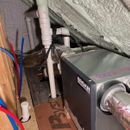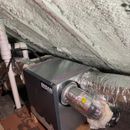Broan AI Series ERV/HRV
Though I just installed one for the first time, I wanted to report an initial positive experience with the Broan “AI” series of ERVs/HRVs: https://www.broan-nutone.com/en-us/ai-series
The differentiating feature of this product line is the ability to specify a desired CFM of balanced ventilation and for the unit to self calibrate accordingly. Upon ‘first boot’, the unit runs a min/max test based on what it can achieve in your specific ducting configuration. You can then specify at what CFM you wish to have it run.
I expect I’ll be experimenting more with controls in the near future, but so far so good.
Probably the only thing I take issue with, thus far, is the “AI” branding, which I suspect is mostly just PID controllers in marketing’s clothing. But hey, that doesn’t make it any less useful.
GBA Detail Library
A collection of one thousand construction details organized by climate and house part












Replies
how's it been since then?
Great! Super quiet, does the job well.
My only regret is that I wish I had a larger area where I could have put a big filter box in front of it. Not until this year would I have thought (because of the Canadian wildfires blowing smoke everywhere) I'd ever consider sometimes putting an activated charcoal filter in.
During the worst periods of smoke, I have had to turn the ERVs off and just wait it out.
Patrick,
Did you by chance have any instrumentation to check how accurate the displayed CFM is? I would be curious how accurate these things are.
Not Patrick but I installed the same ERV in my house about 9 months ago. I used a flow hood to test the ERV return and found it to be within a few CFM of the reported CFM. I also used a manometer to test the houses pressure and found it basically unchanged with the ERV on or off showing that equal amounts of air were being extracted and supplied. I don't think this is a 'standard' test but it made sense to me.
Thanks Steve, that is good to know!
Glad to hear Steve's response. While I do have a lot of tools I have no business in owning, a duct blaster/exhaust fan flow meter is not among them!
On, the AI, you're correct. Nothing special there for controls other then current sensing for the ECM motors that "dials" in the correct CFM. You can do a lot more with simple automation (like varying flow on CO2 etc.)
Don't bother with a basic carbon filter. I've found that this setup actually works great. The canister has about 15lbs of activated charcoal in it. It's the same setup as the cannabis grower folks use. I tried 14x14x4 carbon filters and they did not address the smoke smell or VOC to any appreciable degree in heavier smoke. I still have to build a filter box over it with a bypass (and clean up that penetration before winter), but for a quick fix, it worked great. We've seen a lot of smoke here, and the occasional outdoor skunk spray...the carbon system pictured works extremely well.
interesting - i figured they did self balancing via pressure taps, but you think they just use a combo of fan current and speed as a proxy for pressure drop and flow? does it do this live? like if i turn on a bathroom exhaust fan, will the Broan AI unit increase power to the intake fan to keep the house pressure balanced?
i'm thinking of getting a Broan 210 unit for my 95 cfm need
aside: patrick, I think dennis is on the money here with using a really big filter. the little ERV filters can't do much for wildfire smoke as a once-through (and perhaps not even the big filter?). i've been thinking about wildfire smoke for my project (lake tahoe area) and figured that a single pass merv 13 or HEPA on the input is a good first line of defense, but really the filtration should be in my main fan/furnace system where it's recycling internally at high flow rates through large filters. that's where something like this would be interesting: https://shop.fantech.net/en-US/dm--3000p--hepa--filtration--unit/p95914
Here is my HRV prefilter, which I put in for wildfire smoke and also urban pollution and allergens. It's a 24x24x4 inline filter box from HVACQuick. Inside I have a pair of stacked 2" Accumulair filters, one MERV13 and the other Activated carbon. We haven't had wildfire smoke events since I installed it, but day to day it seems to keep outside odors outside. Except skunks. Their smell gets through everything.
awesome to see! is this a pre-filter before your HRV? and is it inside your building enclosure or outside? i've been thinking about the same, but was worried about condensation on the housing - so thinking about either insulating the units (ugh) or putting it after the ERV where hopefully it'll be above dew point
Yes it's a prefilter feeding into the HRV. It is also within the conditioned envelope. It helps that I'm in the relatively mild Bay Area in a microclimate that never gets below freezing temps. Even on cold days I don't think I've ever seen it condense, because I think my attic is itself preheating the duct.
I have this same box and have tried the 14x14x4 carbon filters. They don't work effectively with high smoke levels of smoke smells. I just keep the MERV13 in there (intake). Mine is on the warm side (preconditioned) side inside the house as we see -35 C temps in winter.
I've also removed the HRV intake fresh air filter (quite restrictive) which effectively is replaced by the external carbon setup. I've not needed to adjust the ECM fan profiles at all, so flow has remained pretty much the same.
Of course it's my luck that we haven't had serious smoke day since I installed the system, but the HVACQuick folks up in Oregon told me they had decent results during their huge smoke event by stacking a pair of 2" filters, one MERV13 and the other carbon. I don't wish for another smoke day, but I don't know another way to validate the setup. Open to ideas though.
To my knowledge, the "AI" software does not respond to other devices (other than to trigger boost/on/off) so would not actively imbalance the unit for make up air.
We recently had a lot of smoke because of the fires in the north. Outside it was definitely smoky, you could smell the smoke (pm2.5 above 150 ug/m3) but the 20x20x2 hepa filter was good enough to filter out both pm2.5 and any smells. Maybe with higher levels smoke a carbon filter is needed.
I don't have a HEPA option on the furnace, or HRV, so the external carbon canister system is the only thing I've found that worked for both heavy smoke and skunks while still maintaining CO2 level managed ventilation rates on the HRV. For a month there we had smoke levels regularly over 100 ppm. Firesmoke.ca is a great resource which offers 48 hour levels and forecasts for smoke.
For activated carbon to work, you need slower velocity air, and enough of a carbon layer to maintain adequate contact time. At 100 CFM, that 8" Carbon canister from Terrabloom works effectively. Surface area is decent (~805 square inches), and the carbon layer is about 1.8" thick.
Danon, sorry about the out of order replies..this web section setup is a bit wonky.
The 2" carbon, 2" MERV13 stack in a 14x14x4 will have some effect, but you'll still smell smoke, and see VOC and PM2.5 increase a fair bit in your home. See my post #13 here.
How often do you have to change that external carbon filter? (And do you have a part number? Perhaps https://www.amazon.com/AC-Infinity-Australian-Charcoal-Hydroponics/dp/B08RRQRWR3) Unfortunately my external intake is in a very inaccessible place (a very steep roof). I might be able to squeeze it indoors before or after the filter box though.
Dennis,
I was not expecting that a HEPA filter would be effective enough for smoke smell. I installed the HEPA stage to deal with ragweed pollen, but I'm glad that I had it in there for the last couple of months.
A carbon filter is definitely better at dealing with smells, I'm pretty sure my filter won't do much for skunk smell or weed smoke. If it is cheap enough and large enough such as the one you installed, it is definitely a good option.
Danon, this is what I'm using: https://terra-bloom.com/products/terrabloom-premium-carbon-filter-8-by-24-750-cfm-australian-carbon-top-rc-48-class-1-8-thick-bed-carbon-air-scrubber-for-indoor-gardens-grow-tents-hydroponics-odor-and-smoke-elimination
The AC infinity unit is similar, but has less carbon so would work ok.
As far as changing them, it depends on conditions, but I'm figuring 18 to 24 months. Once I have the final box made, it will only be used when conditions warrant, so perhaps longer.